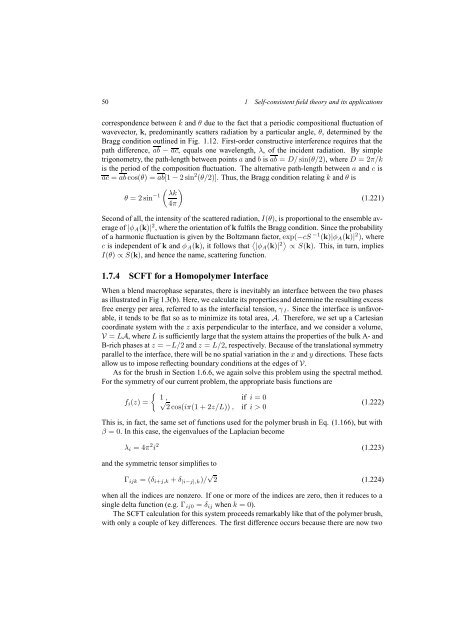Self-Consistent Field Theory and Its Applications by M. W. Matsen
Self-Consistent Field Theory and Its Applications by M. W. Matsen
Self-Consistent Field Theory and Its Applications by M. W. Matsen
Create successful ePaper yourself
Turn your PDF publications into a flip-book with our unique Google optimized e-Paper software.
50 1 <strong>Self</strong>-consistent field theory <strong>and</strong> its applications<br />
correspondence between k <strong>and</strong> θ due to the fact that a periodic compositional fluctuation of<br />
wavevector, k, predominantly scatters radiation <strong>by</strong> a particular angle, θ, determined <strong>by</strong> the<br />
Bragg condition outlined in Fig. 1.12. First-order constructive interference requires that the<br />
path difference, ab − ac, equals one wavelength, λ, of the incident radiation. By simple<br />
trigonometry, the path-length between points a <strong>and</strong> b is ab = D/ sin(θ/2), where D =2π/k<br />
is the period of the composition fluctuation. The alternative path-length between a <strong>and</strong> c is<br />
ac = ab cos(θ) =ab[1 − 2sin 2 (θ/2)]. Thus, the Bragg condition relating k <strong>and</strong> θ is<br />
( ) λk<br />
θ =2sin −1 (1.221)<br />
4π<br />
Second of all, the intensity of the scattered radiation, I(θ), is proportional to the ensemble average<br />
of |φ A (k)| 2 , where the orientation of k fulfils the Bragg condition. Since the probability<br />
of a harmonic fluctuation is given <strong>by</strong> the Boltzmann factor, exp(−cS −1 (k)|φ A (k)| 2 ), where<br />
c is independent of k <strong>and</strong> φ A (k), it follows that 〈 |φ A (k)| 2〉 ∝ S(k). This, in turn, implies<br />
I(θ) ∝ S(k), <strong>and</strong> hence the name, scattering function.<br />
1.7.4 SCFT for a Homopolymer Interface<br />
When a blend macrophase separates, there is inevitably an interface between the two phases<br />
as illustrated in Fig 1.3(b). Here, we calculate its properties <strong>and</strong> determine the resulting excess<br />
free energy per area, referred to as the interfacial tension, γ I . Since the interface is unfavorable,<br />
it tends to be flat so as to minimize its total area, A. Therefore, we set up a Cartesian<br />
coordinate system with the z axis perpendicular to the interface, <strong>and</strong> we consider a volume,<br />
V = LA, where L is sufficiently large that the system attains the properties of the bulk A- <strong>and</strong><br />
B-rich phases at z = −L/2 <strong>and</strong> z = L/2, respectively. Because of the translational symmetry<br />
parallel to the interface, there will be no spatial variation in the x <strong>and</strong> y directions. These facts<br />
allow us to impose reflecting boundary conditions at the edges of V.<br />
As for the brush in Section 1.6.6, we again solve this problem using the spectral method.<br />
For the symmetry of our current problem, the appropriate basis functions are<br />
{ 1 , if i =0<br />
f i (z) = √ (1.222)<br />
2cos(iπ(1 + 2z/L)) , if i>0<br />
This is, in fact, the same set of functions used for the polymer brush in Eq. (1.166), but with<br />
β =0. In this case, the eigenvalues of the Laplacian become<br />
λ i =4π 2 i 2 (1.223)<br />
<strong>and</strong> the symmetric tensor simplifies to<br />
Γ ijk =(δ i+j,k + δ |i−j|,k )/ √ 2 (1.224)<br />
when all the indices are nonzero. If one or more of the indices are zero, then it reduces to a<br />
single delta function (e.g. Γ ij0 = δ ij when k =0).<br />
The SCFT calculation for this system proceeds remarkably like that of the polymer brush,<br />
with only a couple of key differences. The first difference occurs because there are now two
















